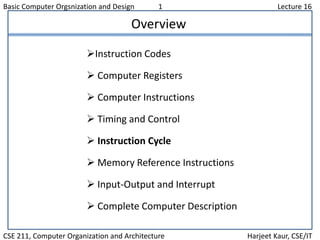
Lecture 16
- 1. Basic Computer Orgsnization and Design 1 Lecture 16 CSE 211, Computer Organization and Architecture Harjeet Kaur, CSE/IT Overview Instruction Codes Computer Registers Computer Instructions Timing and Control Instruction Cycle Memory Reference Instructions Input-Output and Interrupt Complete Computer Description
- 2. Basic Computer Orgsnization and Design 2 Lecture 16 CSE 211, Computer Organization and Architecture Harjeet Kaur, CSE/IT Flow Chart (Instruction Cycle) = 0 (direct) Start SC <-- 0 AR <-- PC T0 IR <-- M[AR], PC <-- PC + 1 T1 AR <-- IR(0-11), I <-- IR(15) Decode Opcode in IR(12-14), T2 D7 = 0 (Memory-reference)(Register or I/O) = 1 II Execute register-reference instruction SC <-- 0 Execute input-output instruction SC <-- 0 M[AR]<--AR Nothing = 0 (register)(I/O) = 1 (indirect) = 1 T3 T3 T3 T3 Execute memory-reference instruction SC <-- 0 T4
- 3. Basic Computer Orgsnization and Design 3 Lecture 16 CSE 211, Computer Organization and Architecture Harjeet Kaur, CSE/IT Determining Type of Instruction D'7IT3: AR M[AR] D'7I'T3:Nothing D7I'T3: Execute a register-reference instr. D7IT3: Execute an input-output instr.
- 4. Basic Computer Orgsnization and Design 4 Lecture 16 CSE 211, Computer Organization and Architecture Harjeet Kaur, CSE/IT Register Reference Instruction r = D7 IT3 => Register Reference Instruction Bi = IR(i) , i=0,1,2,...,11 - D7 = 1, I = 0 - Register Ref. Instr. is specified in b0 ~ b11 of IR - Execution starts with timing signal T3 Register Reference Instructions are identified when r: SC 0 CLA rB11: AC 0 CLE rB10: E 0 CMA rB9: AC AC’ CME rB8: E E’ CIR rB7: AC shr AC, AC(15) E, E AC(0) CIL rB6: AC shl AC, AC(0) E, E AC(15) INC rB5: AC AC + 1 SPA rB4: if (AC(15) = 0) then (PC PC+1) SNA rB3: if (AC(15) = 1) then (PC PC+1) SZA rB2: if (AC = 0) then (PC PC+1) SZE rB1: if (E = 0) then (PC PC+1) HLT rB0: S 0 (S is a start-stop flip-flop)